| PART PRICES |
| GM & GC PARTS |
| Crate Engines |
| Stock |
| Performance |
| Gen 3 & 4 |
| Partial Engines |
| Bare Blocks And Parts |
| Cylinder Heads And Parts |
| 2.4L Twin Cam Supercharger |
| Gauges And Parts |
| Plugs, Wires, And Looms |
| Camshafts And Parts |
| Chrome Parts Made by Proform |
| Distributors And Parts |
| Valve Covers And Parts |
| Starters & Parts |
| Intake Manifolds And Parts |
| Transmission And Parts |
| Engine Oiling System Parts |
| Suspension Parts |
| Shocks And Shock Kits |
| Brakes And Brake Parts |
| Ehxaust Systems |
| AFTERMARKET |
| MSD IGNITION |
| FLUIDAMPR |
| HOLLEY |
| AFR |
| PROFORM |
| RICHMOND |
| R&M |
| B&B |
| ACCEL |
| SCAT |
| EDELBROCK |
| DEMON |
| HUGHES |
| TREMEC |
| Help |
| VEHICLES |
| NOTES |
| Please make sure you have your e-mail address on all of your messages sent to us. |
| If you have been told by your local dealer that a stock part has been discontinued, asking us the same question will not change that fact. |
| The GM high performance discussion board is mainly for our customers to get together and communicate, but it is also for communication with us. |
| Chevrolet - SBC V8 50TH ANNIVERSARY SPECIAL ZZ383-500HPA CRATE ENGINE |
|
The year 2005 marks the 50th anniversary of the small-block Chevy V8 engine. To celebrate this momentous event, Chevrolet has produced a special anniversary addition of our new ZZ383-500 crate engine. This page gives some history on the small-block chevy V8 engine and show some pictures of the ZZ383-500A anniversary engine. We are still finishing putting all this together on our web site. There are more information and pictures coming.The ZZ383-500A is an engine that is exclusively made by Chevrolet. You can’t get this engine anywhere else. Keys - scperformanceeng, gmperformanceeng, or gmgoodwrencheng for SC, GM, or Goodwrench engines. Use allengine for a complete list of all three. |
| 383CI STROKER ENGINES NAVIGATION |
| GMPP HT 383 Main Page | GMPP HT 383 Pictures |
| GMPP HT 383 Parts List | GMPP HT 383 Partial Engine |
| GMPP ZZ383/425 Main Page | Chevrolet Premium ZZ383/425 Main Page |
| Chevrolet ZZ450 Main Page | Chevrolet ZZ450 Pictures |
| Chevrolet The SBC 50th Anniversary. | Chevrolet ZZ383-500 |
| Chevrolet ZZ383-500A Pictures | Chevrolet ZZ383-500 Pictures |
| Chevrolet ZZ383-500 Options Photos | Chevrolet ZZ383-500 Parts Photos |
| We have more GM and Chevrolet Performance Engines available. We have more GM Stock Replacement Long-block Goodwrench Engines available. We have more “Gen 3” and “Gen 4” Design Engines available. (LS1, LS2, LS6, LQ4, LS7) |
|
| SMALL-BLOCK CHEVROLET 50TH ANNIVERSARY |
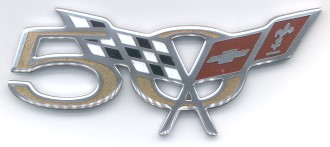 |
Chevrolet Celebrates The 50th Anniversary Of The Chevrolet Small-Block V8 With The ZZ383-500A |
||||||||||||||
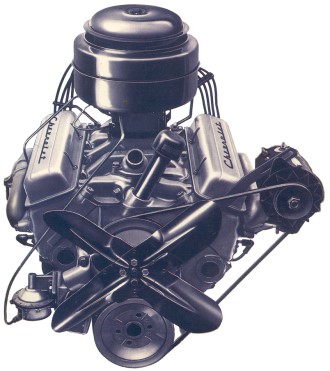 |
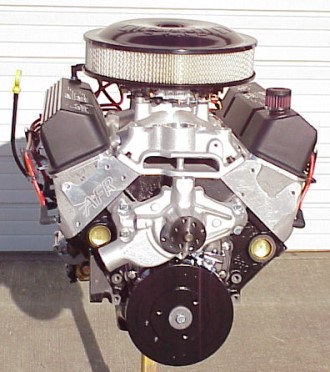 |
||||||||||||||
| The Original 1955 265 Small-Block Engine | The Chevrolet 2005 50th Anniversary ZZ383-500A | ||||||||||||||
| CI | Year | Bore | Stroke | Rod Length |
Main Journal |
Rod Journal |
Main Bolts |
CI | Year | Bore | Stroke | Rod Length |
Main Journal |
Rod Journal |
Main Bolts |
| 265 | 1955 | 3.750 | 3.00 | 5.700 | 2.30 | 2.00 | 2 only | 383 | 2005 | 4.00 | 3.80 | 5.700 | 2.45 | 2.10 | 4 only |
| In 1955 General Motors introduced its most successful engine ever. The small-block V-8 first appeared in a 265ci version and grew as large as 400 ci. This design lasted for 37 years and became known as the first-generation Chevy small-block engine. The Small Block Chevy was the first production engine to produce one horsepower per cubic inch - 283ci/283hp in 1957. This 283ci.283hp small-block was fitted with Rochester mechanical fuel injection (called "Ramjet injection") and churned out an impressive 283 ponies (a number that grew to 290 the following year). The Factory Production Small-Block Chevy 265, 267, 283, 302, 305, 307, 327, 350, 383, 400 |
The special edition Chevrolet ZZ383-500HPA engine is being release at the same time our NEW ZZ383-500HP crate engine is being released. This special anniversary version will only be produced for year 2005, while the ZZ383 will continue on. The new Chevrolet ZZ383-(both versions) puts out an impressive 500 HP @ 5,700 RPM and 491 ft./lbs. @ 4,600 RPM with a maximum recommended RPM of 6,500. The small-block chevrolet V8 engine has come a long way since it’s conception 50 years ago. The 50th Anniversary ZZ383-500HPA features special made CNC valve covers. These valve cover have 1955-2005, ZZ383 500 HP, and a 50th emblem machined into the top of them. (See picture below) |
||||||||||||||
| HISTORY OF THE SMALL BLOCK CHEVY The small-block was introduced in 1955 with 265ci. Unless you are restoring a car and want to be exact in every detail, the early 265 block is not one to use since it has no oil filter. During 1956 this was rectified and the engine continued in production until 1957. In 1957, the engine size was stepped up to 283ci. This engine, with its 3.875in bore and 3.000in stroke, continued production until 1967. Up to about 1958 the small block Chevrolet used a rope type rear main seal, but from this point to the 1986 model the now familiar split neoprene seal was used. In the 1962 model year the Corvette came out with 327ci. This was the first of the 4.000in bore motors, and set the stage for what was to become the most common bore size among small blocks. Equally note worthy is the fact that the stroke was increased to 3.250in. This necessitated larger counterweights and as a result, some substantial internal modifications had to be done to the 283 design to accommodate a crank shaft with larger counterweights. In the 1968 model year when the 350 was introduced, blocks moved into the big journal crankshaft era and the 327 was produced both in small and big journal size. This means if you have a 327 big journal crank, you can make a 327 engine out of a 350. Later 327s from 19681969, when the engine was dropped, had bigger main bearing journals than earlier engines. In 1968, the 307ci engine was introduced as a kind of economy engine. It had the 3.875in bore of the 283 and used a cast crank with the 3.250in stroke of the 327 and was produced up to 1973. From 1967 to 1969, the 302 was produced, although it was probably developed just so Chevrolet had an engine size eligible for TansAm racing. In 1967, it was produced with the small journal crank and in 19681969, with the big journal crank. The year 1967 also saw the introduction of the 350ci engine. This now classic configuration utilized a 4.000in bore with a 3.480in stroke, and has probably become the most common engine size. Along with the introduction of the 350 came the standardization on the big main journals. The next major milestone in terms of performance was the introduction in 1970 of the 400ci block. This deviated from the standard format in many respects. First, it used a nominal 4.125in bore, as opposed to the 4.000in bore that had become the norm. To achieve the 4.125in bore, some internal casting core changes were necessary. The most obvious external change was the use of three freeze plugs in the side of the block. To accommodate this larger bore size, the bores were siamesed; there was no water between the cylinder bores because the barrels joined in the water jacket. In contrast, all other blocks have water completely surrounding each cylinder bore. Along with this change in the bore size, the 400 motor was equipped with a 3.750in stroke cast crankshaft. To get this bore stroke combination within the confines of the standard 9.025in crankshaft center to block deck height it was necessary to shorten rod length if the stock piston ring package was to be retained. The standard 5.70in rod was then shortened to 5.56in. In 1975, the 262ci engine was introduced with a 3.671in bore and a 3.100in stroke. It was intended as a low output economy engine but obviously did not prove popular as it was produced for only one year. In 1976, the 305ci engine was introduced, which must be the most plentiful engine in existence, next to the 350. Built largely for emission and mileage reasons, this engine sports a 3.763in bore with the crankshaft stroke of the 350 at 3.480in. As of 1992, the 305 is still being produced and looks as if it will continue in production for some time. In late 1979, a 267ci engine was introduced. This had a 3.500in bore along with the 3.480in stroke of the 350. Like the earlier 262, it was intended as an economy engine, both in terms of cost and fuel consumption. Again like the 262, it did not prove popular and was produced only through model year 1982. As of 1983, only two displacements of small block were produced the 305 and 350. In 1986, a block design change was made concentrating on the rear main oil seal. Instead of having a split oil seal, the rear main bearing now used a full 360deg. one piece seal. Using this type of block usually requires using the relevant crank and flywheel, as a crankshaft design change was also made. If you have an early crank, Chevrolet has a special seal adaptor kit to convert 1986 and the late block to accept pre 1986 cranks. A hydraulic roller version of this new block was also introduced at about the same time. The roller follower assembly is not interchangeable with later blocks. Unlike aftermarket rollers that are prevented from rotating by linking them in pairs, the General Motors roller setup has special slotted plates that locate lifters and keep the rollers aligned with the cam lobe. Taken from How to Build & Modify Chevrolet Small-Block V-8 Pistons, Rods & Crankshafts, Motorbooks International, 1992 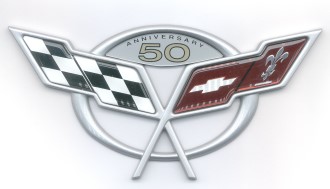 |
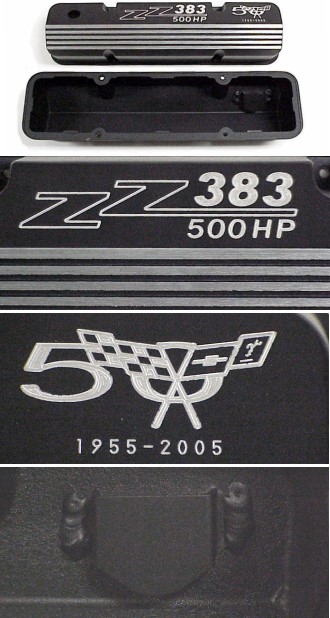 The ZZ383-500A also gets the Proform low profile black paint air cleaner with red Bow Tie and Chevrolet lettering, part number 141-692 which is optional on the ZZ383-500. 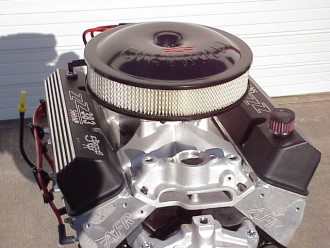 The ZZ383-500 (Both Versions) comes with a Holley 0-82751 4150 Street HP 750 cfm carburetor.  Also included is an Edelbrock aluminum As-Cast short leg water pump and Proform’s chrome timing cover and tab. 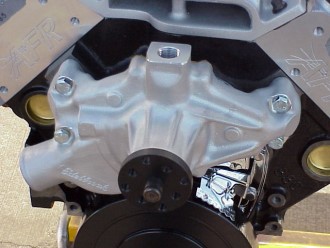 |
||||||||||||||
| The General Motors small block V8 is 50 years old. Your Guide, James Jones From James Jones, Your Guide to Auto Racing. Since 1955 the small block V8 has won more races than any other. Since its introduction in 1955, the GM small-block has powered more winning race cars and won more championships than any other engine in American motorsports. The small-block V-8 made its debut in the 1955 Chevrolet Bel Air by pacing the Indianapolis 500 and scored its first NASCAR win the same year. With 50 years of success in racing and production vehicles, the GM small-block V-8 engine continues to deliver winning horsepower and performance, kicking off the 2005 season with back-to-back Daytona wins in the last two weeks. Jeff Gordon won the Daytona 500 on Sunday while Max Angelelli, Wayne Taylor and Emmanuel Collard scored Pontiac’s second consecutive win at the Rolex 24 at Daytona on Feb. 6. “Our victories in Daytona continue the winning legacy of GM’s small-block engine,” said Mark Kent, director, GM Racing. “Its performance on the race track demonstrates the enduring power of the design.” The small-block V-8 also has a home in today’s GM production vehicles. This year GM introduced the Gen IV small-block V-8 which is available in V-8-equipped models of the 2005 Chevrolet TrailBlazer EXT, GMC Envoy XL, Envoy XUV, Pontiac Grand Prix GXP, and it will also become available in the 2006 Chevrolet Monte Carlo and Impala. A 6.0-liter V-8 version of the Gen IV engine powers the 2005 Chevrolet Corvette, and a 500 horsepower 7.0-liter version will be found in the soon-to-be released 2006 Corvette Z06. GM Powertrain estimates that by the end of the 2005 model year, more than 90 million small-block-based engines will have been produced. That represents 27 billion in total horsepower. With General Motors’ continued commitment to auto racing in all forms, you are sure to be seeing it winning more and more. The New Generation V8s are built on the same classic design as the original V8, but now use computer technology to assist automakers in harnessing it’s power and making it more and more efficient. You'll always hear that it was a Chevy that won. Happy Birthday V8 and many more to come. General Motors Corp. (NYSE: GM), the world’s largest automaker, has been the global industry sales leader since 1931. Founded in 1908, GM today employs about 324,000 people around the world. It has manufacturing operations in 32 countries and its vehicles are sold in 200 countries. In 2004, GM sold nearly 9 million cars and trucks globally, up 4 percent and the second-highest total in the company’s history. GM’s global headquarters are at the GM Renaissance Center in Detroit. More information on GM can be found at www.gm.com. |
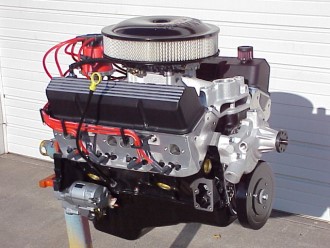 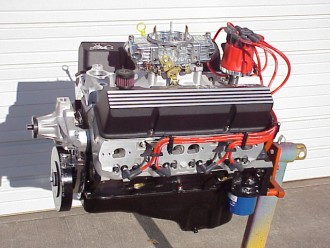 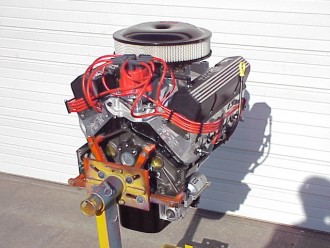 Chevrolet uses a GM High Torque Gear Reduction starter on both versions of the ZZ383-500 500 HP engines. (See photos above)
|
||||||||||||||
| ZZ383-500A Description P/N SCZZ38350TH Same specifications as the Chevrolet ZZ383-500. Only main difference is the special anniversary valve covers that come included. In other words this is the ZZ383-500 with the exception of the special anniversary valve covers instead of the standard included 12480127 - Bow Tie Cast Aluminum valve covers. The air cleaner is the Proform 141-692 that comes with this engine, but like the ZZ383-500 you can choice whichever proform air cleaner you like excluding the 141-790 Chevrolet Genuine Carbon-Fiber Classic 14” which you would have to pay more for if you wanted it. |
|||||||||||||||
| WEB SITE NAVIGATION INFORMATION |
| If you have you just came from a search engine and are stuck with no navigation, turn on Java Scripts in your Web browser, reload the page, then you can turn off Java Scripts again. Also, people using Internet Explorer have to use the pull down tab next to the back button to return to a search engine. More information on this is on our help page. |
| GM and Chevrolet part prices are in the Price & Parts search. Keys are to be used with the Price & Parts Search. Enter a Key, part number, GM, SC, or a key word, like 502, into the Price & Parts search to see if we have it on our site. Use GM for a list of both GM and GMPP parts. Use SC for a list of all Chevrolet exclusive parts. Aftermarket company prices are on downloadable Price Sheets or on their pages. The Page Search is for searching the pages of our Web site. More information on this is on our help page. |